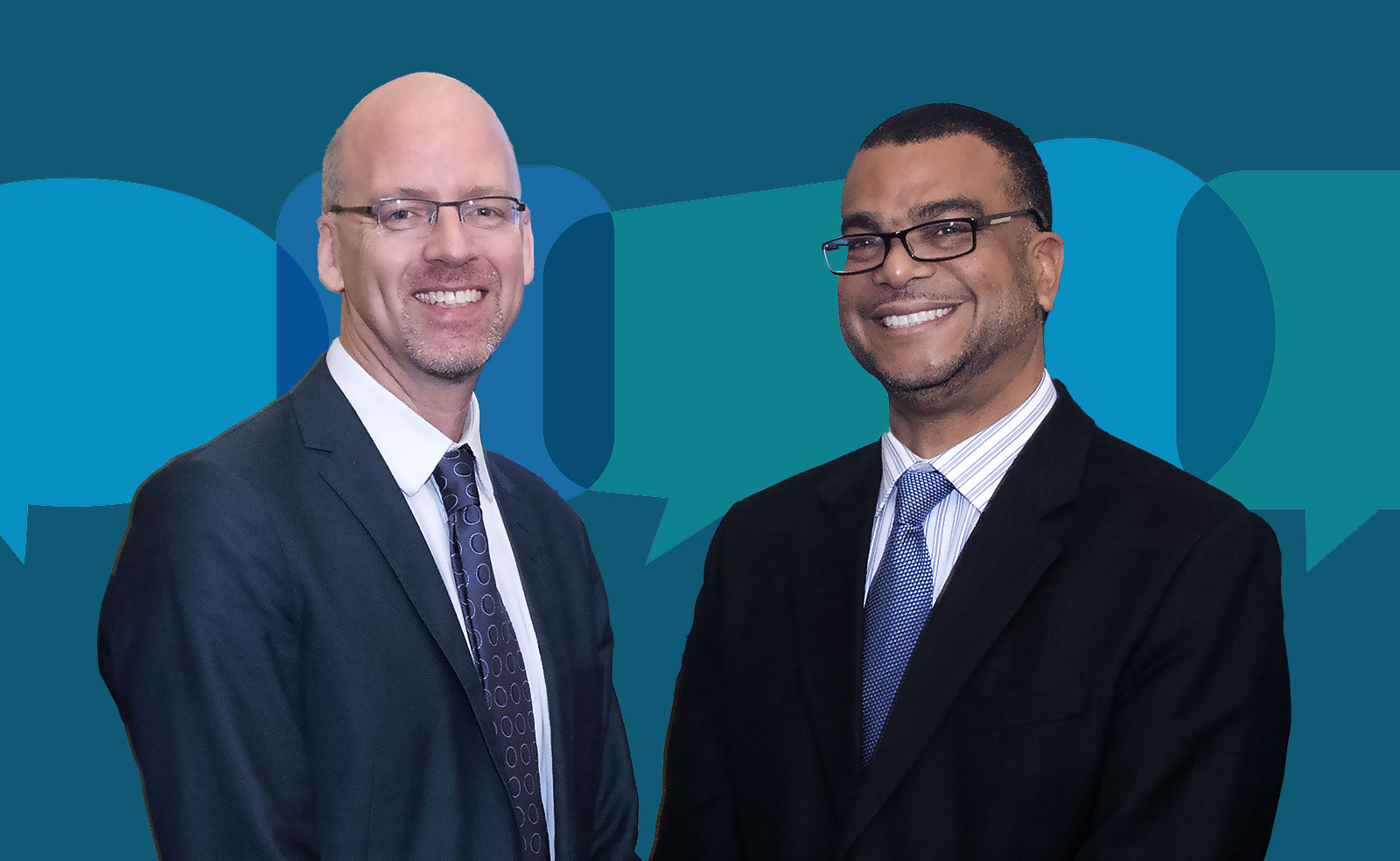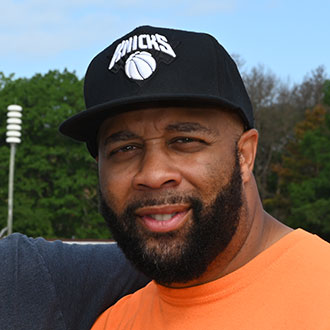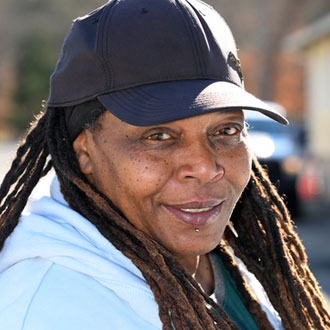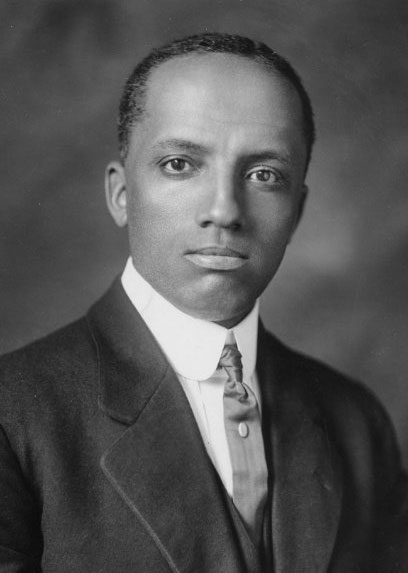


DEI Digest
March 2024

In Conversation
with Deputy Director John Hill
This is the second in a series of conversations between Chief Diversity, Equity and Inclusion Officer Noel Blackburn and senior leadership at Brookhaven National Lab. In this edition, we spotlight Deputy Director for Science and Technology John Hill. John was recently promoted to this role after serving in many different capacities at the Lab during his 30+ year career.
Noel Blackburn: Let's begin with a little bit about your career background: What did you study in college, and what kind of career were you hoping to pursue?
John Hill: I wanted to be a scientist since I was very young. There was never anything else on my mind! I went to college in London where I studied physics as an undergraduate, then came to the US to do my PhD in physics, and went straight from there to BNL as a post-doc. It was always going to be science for me, and ideally research, and so I was very single minded in where I was going!
NB: You came to work for BNL many years ago. What was the first major project you worked on and what do you remember most about that experience?
JH: I began in the Physics Department, where I was doing experiments at the old National Synchrotron Light Source. What I remember most was the long hours at the beamline taking data. They were pretty small experiments, with only two or three people working on them, so you got to be really intimate with the whole thing—with the beamline, the data taking, the analysis and the writing of the paper, you got to do all of it, which I really enjoyed! We did what seemed like really cool experiments back then. Now they look really boring, but back then, this was in the early 1990’s, they were exciting. For example, we looked at Chromium—just the metal chromium, a big single crystal—and we saw some magnetic signal with x-rays for the first time and got very excited. Now at NSLS-II, that same experiment could be done now on a much smaller sample, much faster, under much more interesting conditions, but back then, it was an exciting thing to be able to do.
NB: Through the years you've served in many different capacities. What were some of the challenges you faced along the way?
JH: As NSLS-II Director, the challenge was to take what was a brand new facility and help turn it into a thriving user facility. To do this, we needed a team of scientists, engineers, technicians, administrative staff and operations staff all working towards delivering the science for the users. I really learned a lot there about the importance of everyone contributing to that mission in order to be successful. That's something that really stuck with me, the combination of people needed to make a team like that work.
NB: You are now Deputy Director for Science and Technology under Lab Director JoAnne Hewett. How has the transition to this new role been?
JH: It's definitely been a big transition! It's a step up in terms of the breadth of stuff that I have to think about. As NSLS-II Director, I knew one part of the Lab. But now, seeing the whole Lab, and how it all fits together, has been a big step up in terms of the perspective and that has been a lot of fun for me. And working with JoAnne has been a great pleasure. She's a very personable leader, she cares a lot about the people here and the science that we are doing and has clear ideas about where she wants the Lab to go. It's been a really exciting time as the three of us—myself, JoAnne, and Deputy Director for Operations Ann Emrick—begin to lead the Lab forward.
NB: As you know, JoAnne is a huge supporter of the DEIA efforts here at the Lab. How do you see DEIA helping to meet the scientific mission of BNL?
JH: I think it's absolutely crucial. In terms of the scientific mission, we need everyone working together to deliver on the potential of BNL. What we're trying to do here is hard, building these incredible machines, pushing the edge of science forward, that's a really difficult thing to do and requires a very wide range of skills to do successfully. That can only work if everyone on the team feels accepted, valued and fully included. So for me, that's the core of DEIA: Having people come to work feeling like they can speak up, like they can make their contribution and that they will be valued. Science is a team sport. We need everyone at the top of their game!
NB: We currently have 8 MOUs--Memorandum of Understanding with Minority-Serving Institutions (MSIs). From your perspective, how does the MOU schools program advance the DEIA effort here?
JH: I think we have to think hard about what we want to get out of the MOU schools. What's really important in any of these relationships is that they are deep and sustained, and not one offs—not just for show. I think by setting up an MOU with a particular school, we're saying to them, “We are in it for the long haul with you.” That commitment is noted and felt and that allows us to establish the deep working relationships needed, so that we can deliver on the promise of the MOU.
NB: You have undergone the management council DEIA trainings—Building a Respectful Workplace by Addressing Microaggression and Mitigating Bias in the Workplace: Overcoming Unconscious Decisions that Lead to Unexpected Consequences. How have those trainings influenced your thoughts around DEIA in the scientific arena?
JH: They've been good trainings and they do definitely make a difference, in me and hopefully in others too. The unconscious bias was an early eye opener for me. By definition you are unaware of such biases. For example, that course showed me that I had a bias towards schools like MIT because of where I came from. I realized I was thinking that we should be looking for people from similar schools, because I had a good experience there and because we want great people. So just recognizing that bias in myself and saying wait a minute, “Are the best people always coming from schools such as MIT?” was important. That was a useful learning experience.
The other example I would give is the micro aggressions course, where I learned that if you see something in the moment but don't say anything, that doesn't mean it's too late. I’d had an experience where I saw something in a meeting, but didn’t say anything, and the moment passed. But as a result of the course, I circled back afterwards and talked to the people involved and I think it made a difference to the individuals. It is not as good as addressing it in the moment (where everyone can see it), but it taught me that it's never too late—if you come back to it, you can still help.
NB: What do you think the Lab will look like 10 years from now and how can DEIA help us achieve that?
JH: We want the Lab to be dynamic, vibrant, growing and successful in ten years’ time. That is going to require an engaged, motivated workforce working together. DEIA will be integral in achieving this vision.
In 10 years, the demographics in this country won’t look like they do now. The workforce will be more diverse, and we need to able to win the competition to get the best people in that workforce to come to BNL to be able to deliver on our science. We want the best people to come here because they feel welcomed, accepted and because they’re going to do something exciting. And that's all part of DEIA to me.
Also, people are going to be contributing to large teams and we need that to work well. There will be people here, spread across the Lab, some may be remote and we’re going to be pulling in partners from across the country and across the world. We might not all be here every single day of the week, and yet we still need to function as a team, so people will need to feel included if they’re going to contribute to the science. DEIA is going to be necessary to integrate everyone who’s contributing into a real team.
NB: I’d like to wrap up with a few “quick hit” questions. Ready? First is: Besides your parents, who were one or two inspirations for you growing up?
JH: I had two teachers who made a huge difference in my life. My physics teacher when I was 14 was a really special person. Someone I connected with, someone who was really excited by the science. I actually dedicated my PhD thesis to him. And then my English teacher was another real character. I do like writing, and he inspired that in me. So those two teachers, both when I was 14, were really important.
NB: Next quick-hit question: What are two unique things about you that most of us wouldn’t know?
JH: I think everyone knows everything about me! Maybe you didn't know I was a twin. There’s one thing! And I’m a lifelong Arsenal fan. I know you’re a Chelsea fan, Noel! They’re both from London so of course they are deadly rivals. It's been up and down over the years as to who's been on top, but Arsenal are right now and I am enjoying that!
NB: Final question: If you could have a superpower, what would yours be? And how would you use it to help people?
JH: I read a science fiction book once about people who had the ability to create clones of themselves that could go off and do various kinds of work and then come back at the end of the day and kind of integrate the knowledge into the original body. It's an obvious answer, but if there were more of me, I could be out and about in the Lab more and understanding more about what the Lab is doing and what problems people are facing and then bring those experiences back here to me. That would be a really useful superpower!
DEIA enables the Lab's mission by fostering a psychologically safe environment for everyone to be authentic and productive in a respectful and diverse workplace so that the Laboratory and its staff can reach their fullest potential.
Diverse Perspectives
In this video series from the Diversity, Equity & Inclusion Office, members of Brookhaven National Lab staff share stories about their DEIA experiences at work and in life. In this video, meet ESH Engineer Jennifer Higbie.
We'd love to have you tell your story in the Diverse Perspectives video series. If you're interested, Email us
Noel Blackburn Visits Facilities & Operations POD meetings
Frequently, when organizations tackle DEI initiatives, their emphasis is primarily on recruiting new individuals to join the organization. And while this is important for Brookhaven, Noel Blackburn knows the value of the diversity already found within. This is why, for the last six months, Noel has been joining “Plan of the Day”—a.k.a. POD meetings—among the Facilities & Operations (F&O) Directorate, which include Campus Development, Energy & Utilities Division, Guest Services Division, Integrated Facility Management, Laboratory Protection Division, and Operational Support and Planning Division.
According to Tom Daniels, F&O Associate Lab Director, Noel’s visits have been very well received. “He's making sure everyone really understands what his role is as part of the leadership team and that he’s representing all of us. And he’s been doing a really good job of making sure everyone knows how important the role they play is to the mission of the laboratory. Even if you’re a craft staff member, your work is still essential to accomplishing the science mission.” Part of the reason Noel’s visits have made an impact is that, despite his current leadership role, Noel started in the field himself, working side by side with Tom on environmental cleanups. “We were literally in the mud together,” Tom recalls fondly. “And that means Noel comes across as real. He comes from a position of understanding what it's like to work every day in those conditions.”
"These small group meetings allowed me to honor the promise I made when I assumed my role as CDO to meet with everyone from the directorate,” says Noel. “Meeting with the F&O staff enabled me to promote respect through a more intimate engagement, where I could thank everyone for their continued commitment to BNL’s excellence and to define the DEIA effort at the Lab. It was invigorating and exciting to meet individuals where they are. This is DEIA in action!”
Noel’s POD meeting visits are still ongoing so if you’re an F&O team member and haven’t had the chance to meet him yet, you will.
F&O Team Members Speak

“When Noel came to our meeting, he shook everyone's hand. That felt great, coming from someone in his position. It showed appreciation—and that goes a long way. He showed us we all have meaning.”
Troy Goode, F&O Production Division

“Even though it was a few months ago, I still feel the vibe that Noel left behind. He pumped us up about wanting the Lab to be a great working environment, where everyone is on the same playing field, working towards one cause, which is to make the Lab the best it can be.”
Tina Trotman, F&O Production Division
DEIA Did You Know? The History of Heritage Months

Carter Woodson
While heritage months or awareness months are now observed throughout the year, the recognition of the contributions of diverse groups to the cultural and economic growth of the U.S. wasn't always commonplace. Historian Carter Woodson noticed the absence of African American history in the nation's curriculum and established Negro History Week in 1926. Woodson selected the second week of February to coincide with the birthdates of both Frederick Douglass and Abraham Lincoln, recognizing them as symbols of freedom. Nonetheless, it took until 1976—50 years!—for President Gerald Ford to officially designate February as Black History Month.
Similarly, Women’s History Month originated as a single week, beginning in 1978 during the week of March 8th, which aligns with International Women’s Day. It wasn’t until nearly a decade later, in 1987, that Congress designated the full month of March as Women’s History Month. This month, we salute all women here at Brookhaven for their contributions to Lab, and by extension, to this country and the world. Happy Women’s History Month!
Raise Your Voice!
Our efforts are a work in progress, evolving over time as we move the needle to change the culture at the Lab. We welcome feedback—positive or negative. If you feel comfortable, email us. If you want to remain anonymous, that’s okay too—send us mail at Mail Stop 400B.


